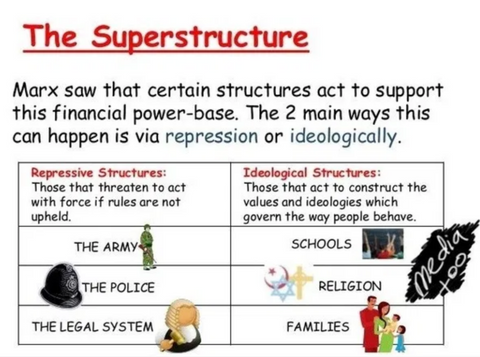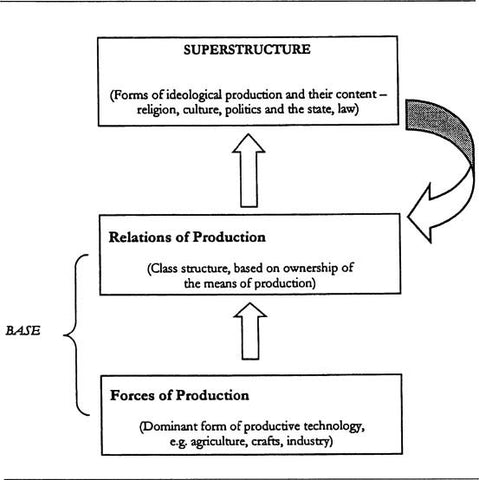




Base & Superstructure
Please allow 10 working days to process before shipping
White Short Sleeve
100% Combed Ring Spun Cotton
Profits to: Incarcerated Workers Organizing Committee

Philosopher Karl Marx explains the idea of our social dynamic as a system composed of a Base and Superstructure are two linked theoretical concepts: Base refers to the production forces, or the materials and resources, that generate the goods society needs as well as the relations of production like employer–employee work conditions, the technical division of labor, and property relations, into which people enter to produce the necessities and amenities of life.

Superstructure describes all other aspects of society including the culture, ideology, norms, and identities that people inhabit. In addition, it refers to the social institutions, political structure, and the state—or society's governing apparatus. Marx argued that the superstructure grows out of the base. The superstructure is shaped by the ruling class as its regulation of industry ultimately dictates the intellectual shape of a society. As such, the superstructure justifies how the base operates and defends the power of the elite. While the relation of the two parts is not strictly unidirectional, as the superstructure often affects the base, the influence of the base is predominant.

Marx believed that the shift to a capitalist mode of production had sweeping implications for the social structure. He asserted that it reconfigured the superstructure in drastic ways and instead posed a “materialist” way of understanding history. Known as "historical materialism," this idea posits that what we produce in order to live determines all else in society. Building on this concept, Marx posed a new way of thinking about the relationship between thought and lived reality.


Importantly, Marx argued that this is not a neutral relationship, as a great deal depends on the way the superstructure emerges from the base. The place where norms, values, beliefs, and ideology reside, the superstructure legitimizes the base. It creates the conditions in which the relations of production seem fair and natural, though they may actually be unjust and designed to benefit the ruling class only.


Neither the base nor the superstructure is naturally occurring or static. They are both social creations, or the accumulation of constantly evolving social interactions between people. So when a society topples and a revolutionary interest rises to the top, a new base will appear, and therefore a new superstructure will be created, until the new ruling class fails to sway public opinion. The superstructure also implies the obfuscation of the proletariat. Essentially, Marx argues that the social glue that holds societies in a state of stability is that the proletariat is hypnotized by rhetoric that prevents them from seeing that the economy is designed to prevent them from succeeding, while higher powers use their resources.

In his early writing, Marx committed himself to the principles of historical materialism and the causal relationship between base and superstructure. However, as his theory grew more complex, Marx reframed the relationship between base and superstructure as dialectical, meaning that each influences the other. Hence, if the base changes so does the superstructure; the reverse occurs as well.

How Marx considered dialectics was different from his contemporaries. The convention at the time in philosophy was to accept Hegelian dialectics, which emphasized the idealist observation that human experience is dependent on the mind's perceptions. Marx developed an alternative rooted in the materialist view instead of the idealist one. Marx’ dialectics emphasize that the world as it concretely exists shapes socioeconomic interactions and that those in turn determine sociopolitical reality.

As a student Marx was influenced by Hegel. He became a member of The Young Hegelians, a student group interpreting Hegel to understand current events. Based on Hegel’s ideas, they saw the entire state apparatus as ultimately claiming legitimacy based upon religious tenets. While this was based on the function of Lutheranism in Prussia at the time, the Young Hegelians held the theory to be applicable to any state backed by any religion. The group undermined what they felt was the corrupt and despotic state apparatus by attacking the philosophical basis of religion.

Marx later diverged from his peers concluding that religion is not the basis of the establishment's power, but rather ownership of capital lies at the heart of the establishment's power. Marx instead considered religion as a component of the ideological superstructure of societies, and a pre-rational mode of thought, which was wielded by ruling elites to obscure social relationships including the true basis of political power.

Marx and Engels both concluded that Hegelian philosophy, at least as interpreted by their former colleagues, was too abstract and was being misapplied in attempts to explain the social injustice in recently industrializing countries such as Germany, France, and the United Kingdom.

As he developed an alternate theory of dialectics as a way to understand history, Marx emphasized the importance of real-world conditions, in terms of class, labor, and socioeconomic interactions. This is in contrast to the Hegelian dialectic, which emphasizes the observation that contradictions in material phenomena could be resolved by analyzing them and synthesizing a solution whilst retaining their essence. Marx supposed that the most effective solution to the problems caused by said contradictory phenomena was to address and rearrange the systems of social organization at the root of the problems.

In German Ideology (1845), Marx called the relationship between his materialist interpretation of history and Hegel's idealistic conception of history a reversal. In the 1873 Afterward to the second German edition of Das Kapital Marx wrote:


Post Marx, debates focused on many aspects of his theories, none more contentiously than on this image of base and superstructure. Some of his followers argued that according to Marx the economic base was the sole determinant of the institutional and ideological superstructure. Others argued that this unidirectional causality held true only in the end or in the long run or in the last instance or fundamentally.

Althusser, confronting a debate in the French intellectual world between “orthodox” Marxists who offered a simplified base/superstructure analysis and post-Marxists who opted for the view that the evolution of a society has multiple determinants, of which the economic is the most important, but by no means the only, factor.
https://robertpaulwolff.blogspot.com/2017/04/overdetermination.html

Marx's theory of base and superstructure can be found in the disciplines of political science, sociology, anthropology, and psychology as utilized by Marxist scholars. Across these disciplines the base-superstructure relationship, and the contents of each, may take different forms.

Max Weber
Early sociologist Max Weber preferred a form of structuralism over a base and superstructure model of society in which he proposes that the base and superstructure are reciprocal in causality—neither economic rationality nor normative ideas rule the domain of society. In summarizing results from his East Elbia research he notes that, contrary to the base and superstructure model "we have become used to," there exists a reciprocal relationship between the two.

Antonio Gramsci
The Italian political philosopher Antonio Gramsci divided Marx's superstructure into two elements: political society and civil society. Political society consists of the organized force of society (such as the police and military) while civil society refers to the consensus-creating elements that contribute to cultural hegemony. Both constituents of this superstructure are still informed by the values of the base, serving to establish and enforce these values in society.

Walter Rodney
Walter Rodney, the Guyanese political activist and African historian, discussed the role of Marx's superstructure in the context of development cycles and colonialism. Rodney states that while most countries follow a developmental structure that evolves from feudalism to capitalism, China is an exception to this rule and skipped the capitalism step.

"The explanation is very complex, but in general terms the main differences between feudal Europe and feudal China lay in the superstructure – i.e. in the body of beliefs, motivations and sociopolitical institutions which derived from the material base but in turn affected it. In China, religious, educational and bureaucratic qualifications were of utmost importance, and government was in the hands of state officials rather than being run by the landlords on their own feudal estates."

By extension this means that the Marxist development cycle is malleable due to cultural superstructures, and is not an inevitable path. Rather the role of the superstructure allows for adaptation of the development cycle, especially in a colonial context.

Wilhelm Reich
Freudo-Marxist Wilhelm Reich's discipline of analysis known as sex economy is an attempt to understand the divergence of the perceived base and superstructure that occurred during the global economic crisis from 1929 to 1933. To make sense of this phenomenon, Reich recategorized social ideology as an element in the base—not the superstructure. In this new categorization, social ideology and social psychology is a material process that self-perpetuates, the same way economic systems in the base perpetuate themselves. Reich focused on the role of sexual repression in the patriarchal family system as a way to understand how mass support for Fascism could arise in a society.

'Radical chic' is not something that the left should flee from—very much to the contrary, it is something that it must embrace and cultivate. The moment of the left's failure coincided with the growing perception that 'radical' & 'chic' were incompatible. It's also time to reclaim & positivise sneers like 'designer socialism', for it was the equation of 'designer' with 'capitalist' that equated capital with the modern.

“Instead of the 'no logo' call for a retreat from semiotic productivity, why not an embrace of all the mechanisms of semiotic-libidinal production in the name of a post-capitalist counterbranding? - Mark Fisher
